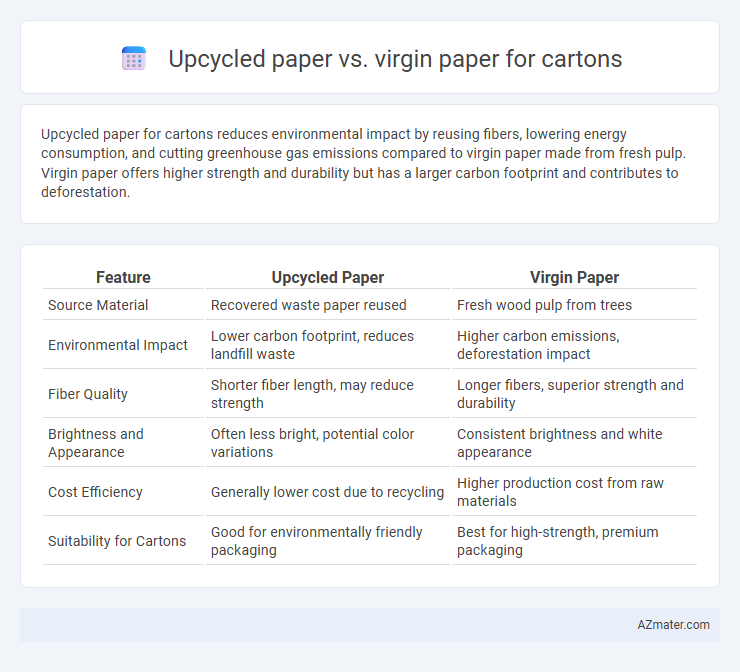Upcycled paper for cartons reduces environmental impact by reusing fibers, lowering energy consumption, and cutting greenhouse gas emissions compared to virgin paper made from fresh pulp. Virgin paper offers higher strength and durability but has a larger carbon footprint and contributes to deforestation.
Table of Comparison
| Feature | Upcycled Paper | Virgin Paper |
|---|---|---|
| Source Material | Recovered waste paper reused | Fresh wood pulp from trees |
| Environmental Impact | Lower carbon footprint, reduces landfill waste | Higher carbon emissions, deforestation impact |
| Fiber Quality | Shorter fiber length, may reduce strength | Longer fibers, superior strength and durability |
| Brightness and Appearance | Often less bright, potential color variations | Consistent brightness and white appearance |
| Cost Efficiency | Generally lower cost due to recycling | Higher production cost from raw materials |
| Suitability for Cartons | Good for environmentally friendly packaging | Best for high-strength, premium packaging |
Introduction to Upcycled and Virgin Paper in Carton Production
Upcycled paper in carton production utilizes reclaimed fibers from previously used paper materials, significantly reducing environmental impact by lowering raw material consumption and energy usage. Virgin paper, derived directly from freshly harvested wood pulp, offers higher strength and uniformity essential for packaging requiring durability and premium quality. Carton manufacturers balance the sustainability benefits of upcycled paper with the mechanical properties of virgin fibers to optimize both environmental performance and product integrity.
Environmental Impact: Upcycled vs. Virgin Paper
Upcycled paper cartons significantly reduce deforestation and lower carbon emissions compared to virgin paper cartons produced from freshly harvested trees. The recycling process for upcycled paper conserves water and energy, resulting in a smaller ecological footprint throughout the carton manufacturing cycle. Choosing upcycled paper supports circular economy principles by minimizing landfill waste and promoting resource efficiency over the resource-intensive extraction required for virgin paper products.
Resource Consumption and Sustainability
Upcycled paper for cartons significantly reduces resource consumption by reusing fibers, cutting water usage by up to 60% and energy needs by nearly 40% compared to virgin paper production. Virgin paper relies heavily on fresh timber, leading to higher deforestation rates and increased carbon emissions. Choosing upcycled paper enhances sustainability by minimizing landfill waste and conserving natural resources, aligning with eco-friendly packaging goals.
Manufacturing Process Differences
Upcycled paper for cartons involves reprocessing used paper materials, which reduces energy consumption and raw fiber extraction compared to virgin paper, made from fresh wood pulp requiring intensive mechanical and chemical treatments. The manufacturing process of virgin paper demands significant water usage and chemical bleaching to transform wood into pulp, whereas upcycled paper emphasizes fiber recovery and minimal processing to maintain material integrity. Upcycled paper manufacturing supports sustainability by lowering carbon footprint and waste generation while virgin paper production often incurs higher environmental impact due to resource intensity.
Performance and Durability Comparison
Upcycled paper cartons often exhibit reduced fiber strength and reduced durability compared to virgin paper cartons, which use fresh fibers providing superior structural integrity. Virgin paper cartons demonstrate enhanced performance in load-bearing capacity, resistance to moisture, and print quality, making them more reliable for heavy-duty packaging applications. However, advancements in recycling technology have improved the quality of upcycled paper, narrowing the performance gap while promoting environmental sustainability.
Cost Analysis: Upcycled vs. Virgin Carton Paper
Upcycled carton paper generally offers a cost advantage over virgin paper due to lower raw material expenses and reduced energy consumption during production, which translates into significant savings in large-scale manufacturing. Virgin paper, while often preferred for its superior strength and quality, incurs higher costs from timber harvesting, pulping, and chemical treatments. Businesses aiming to balance sustainability with budget constraints should consider upcycled carton paper as a financially efficient alternative without compromising functional performance.
Visual and Textural Qualities
Upcycled paper cartons exhibit a distinct rustic texture with visible fibers and natural color variations, enhancing their artisanal and eco-friendly appeal. Virgin paper cartons offer a smoother, more uniform surface, allowing for sharper, more vibrant printing and consistent branding visuals. The tactile experience of upcycled cartons feels more organic and textured, while virgin paper provides a sleek, polished finish ideal for premium packaging.
Regulatory and Certification Considerations
Upcycled paper cartons often comply with stringent environmental regulations such as the Forest Stewardship Council (FSC) Recycled certification and the Sustainable Forestry Initiative (SFI), ensuring reduced environmental impact through resource conservation. Virgin paper cartons may require adherence to regulations protecting natural forest resources, and often carry FSC or Programme for the Endorsement of Forest Certification (PEFC) certifications that guarantee sustainable forestry practices. Regulatory frameworks increasingly favor upcycled paper for carton production due to lower carbon footprints and reduced deforestation risks, influencing industry standards and consumer preferences.
Industry Trends and Consumer Preferences
Upcycled paper cartons are gaining traction in the packaging industry due to increasing consumer demand for sustainable and eco-friendly products, driving brands to adopt recycled materials to reduce environmental impact. Market analysis indicates a shift towards upcycled paper cartons as they offer significant carbon footprint reduction compared to virgin paper, aligning with corporate social responsibility goals. Industry trends highlight advancements in upcycled paper quality and durability, making it a competitive alternative to traditional virgin paper cartons in packaging applications.
Conclusion: Choosing the Right Paper for Cartons
Selecting upcycled paper for cartons offers significant environmental benefits by reducing deforestation and lowering energy consumption during production. Virgin paper provides superior strength and durability, essential for heavy-duty packaging needs requiring maximum protection. Balancing sustainability goals with functional requirements ensures the optimal choice between upcycled and virgin paper for carton manufacturing.

Infographic: Upcycled paper vs Virgin paper for Carton
 azmater.com
azmater.com